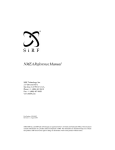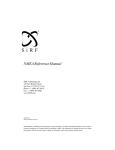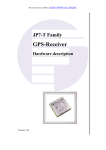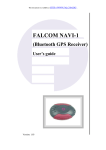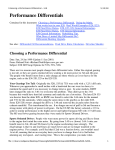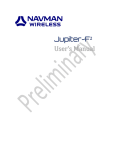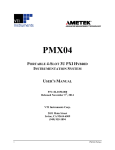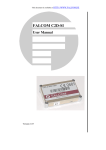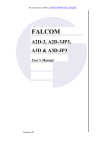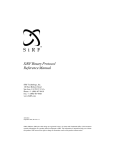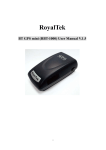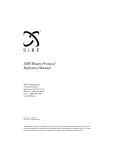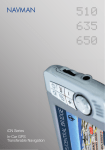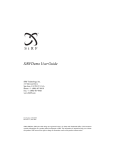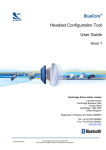Download SiRFstarIIeLP Evaluation Kit User's Guide
Transcript
NMEA R eferenc e Manual NMEA Reference Manual SiRF Technology, Inc. 148 East Brokaw Road San Jose, CA 95112 U.S.A. Phone: +1 (408) 467-0410 Fax: +1 (408) 467-0420 www.SiRF.com 1050-0042 December 2002, Revision 1.0 SiRF, the SiRF logo, and SiRFstar identity are registered trademarks of SiRF Technology, Inc. This document contains information on a product under development at SiRF. The information is intended to help you evaluate this product. SiRF reserves the right to change or discontinue work on this product without notice. NMEA Reference Manual © 2002 SiRF Technology, Inc. All rights reserved. No part of this work may be reproduced or transmitted in any form or by any means, electronic or mechanical, including photocopying and recording, or by any information storage or retrieval system without the prior written permission of SiRF Technology, Inc. unless such copying is expressly permitted by United States copyright law. Address inquiries to Legal Department, SiRF Technology, Inc., 148 East Brokaw Road, San Jose, California 95112, United States of America. About This Document This document contains information on SiRF products. SiRF Technology, Inc. reserves the right to make changes in its products, specifications and other information at any time without notice. SiRF assumes no liability or responsibility for any claims or damages arising out of the use of this document, or from the use of integrated circuits based on this document, including, but not limited to claims or damages based on infringement of patents, copyrights or other intellectual property rights. SiRF makes no warranties, either express or implied with respect to the information and specifications contained in this document. Performance characteristics listed in this data sheet do not constitute a warranty or guarantee of product performance. All terms and conditions of sale are governed by the SiRF Terms and Conditions of Sale, a copy of which you may obtain from your authorized SiRF sales representative. Getting Help If you have any problems contact your SiRF representative or call or send an e-mail to the SiRF Technology support group: phone +1 (408) 467-0410 e-mail [email protected] iii Contents Preface . . . . . . . . . . . . . . . . . . . . . . . . . . . . . . . . . . . . . . . . . . . . . . . xxi 1. Output Messages . . . . . . . . . . . . . . . . . . . . . . . . . . . . . . . . . . . . . . . 1-1 GGA —Global Positioning System Fixed Data . . . . . . . . . . . . . . . . . . 1-2 GLL—Geographic Position - Latitude/Longitude . . . . . . . . . . . . . . . . 1-2 GSA—GNSS DOP and Active Satellites. . . . . . . . . . . . . . . . . . . . . . . 1-3 GSV—GNSS Satellites in View . . . . . . . . . . . . . . . . . . . . . . . . . . . . . 1-4 MSS—MSK Receiver Signal. . . . . . . . . . . . . . . . . . . . . . . . . . . . . . . . 1-4 RMC—Recommended Minimum Specific GNSS Data . . . . . . . . . . . . 1-4 VTG—Course Over Ground and Ground Speed . . . . . . . . . . . . . . . . . 1-5 2. Input Messages . . . . . . . . . . . . . . . . . . . . . . . . . . . . . . . . . . . . . . . . 2-1 Transport Message . . . . . . . . . . . . . . . . . . . . . . . . . . . . . . . . . . . . . . . . 2-1 NMEA Input Messages . . . . . . . . . . . . . . . . . . . . . . . . . . . . . . . . . . . . 2-2 100—SetSerialPort . . . . . . . . . . . . . . . . . . . . . . . . . . . . . . . . . . . . . . . 2-2 101—NavigationInitialization . . . . . . . . . . . . . . . . . . . . . . . . . . . . . . . 2-3 102—SetDGPSPort . . . . . . . . . . . . . . . . . . . . . . . . . . . . . . . . . . . . . . . 2-4 v vi 103—Query/Rate Control . . . . . . . . . . . . . . . . . . . . . . . . . . . . . . . . . . 2-5 104—LLANavigationInitialization . . . . . . . . . . . . . . . . . . . . . . . . . . . 2-6 105—Development Data On/Off . . . . . . . . . . . . . . . . . . . . . . . . . . . . . 2-7 106—Select Datum . . . . . . . . . . . . . . . . . . . . . . . . . . . . . . . . . . . . . . . 2-7 MSK—MSK Receiver Interface . . . . . . . . . . . . . . . . . . . . . . . . . . . . . 2-8 NMEA Reference Manual—December 2002 Figures xiii xiv NMEA Reference Manual—December 2002 Tables Table 1-1 NMEA Output Messages . . . . . . . . . . . . . . . . . . . . . . . . . . . . . . . . . 1-1 Table 1-2 Supported NMEA output messages . . . . . . . . . . . . . . . . . . . . . . . . . 1-1 Table 1-3 GGA Data Format . . . . . . . . . . . . . . . . . . . . . . . . . . . . . . . . . . . . . . 1-2 Table 1-4 Position Fix Indicator . . . . . . . . . . . . . . . . . . . . . . . . . . . . . . . . . . . . 1-2 Table 1-5 GLL Data Format . . . . . . . . . . . . . . . . . . . . . . . . . . . . . . . . . . . . . . . 1-3 Table 1-6 GSA Data Format . . . . . . . . . . . . . . . . . . . . . . . . . . . . . . . . . . . . . . . 1-3 Table 1-7 Mode 1 . . . . . . . . . . . . . . . . . . . . . . . . . . . . . . . . . . . . . . . . . . . . . . . 1-3 Table 1-8 Mode 2 . . . . . . . . . . . . . . . . . . . . . . . . . . . . . . . . . . . . . . . . . . . . . . . 1-3 Table 1-9 GSV Data Format . . . . . . . . . . . . . . . . . . . . . . . . . . . . . . . . . . . . . . . 1-4 Table 1-10 MSS Data Format . . . . . . . . . . . . . . . . . . . . . . . . . . . . . . . . . . . . . . . 1-4 Table 1-11 RMC Data Format . . . . . . . . . . . . . . . . . . . . . . . . . . . . . . . . . . . . . . 1-5 Table 1-12 VTG Data Format. . . . . . . . . . . . . . . . . . . . . . . . . . . . . . . . . . . . . . . 1-5 Table 2-1 Supported NMEA input messages . . . . . . . . . . . . . . . . . . . . . . . . . . 2-2 Table 2-2 Set Serial Port Data Format . . . . . . . . . . . . . . . . . . . . . . . . . . . . . . . 2-3 Table 2-3 Navigation Initialization Data Format . . . . . . . . . . . . . . . . . . . . . . . 2-3 Table 2-4 Reset Configuration - Non SiRFLoc Platforms . . . . . . . . . . . . . . . . 2-4 xv xvi Table 2-5 Reset Configuration - SiRFLoc Specific . . . . . . . . . . . . . . . . . . . . . 2-4 Table 2-6 Set DGPS Port Data Format . . . . . . . . . . . . . . . . . . . . . . . . . . . . . . . 2-4 Table 2-7 Query/Rate Control Data Format (See example 1) . . . . . . . . . . . . . 2-5 Table 2-8 Messages . . . . . . . . . . . . . . . . . . . . . . . . . . . . . . . . . . . . . . . . . . . . . 2-5 Table 2-9 LLA Navigation Initialization Data Format . . . . . . . . . . . . . . . . . . . 2-6 Table 2-10 Reset Configuration . . . . . . . . . . . . . . . . . . . . . . . . . . . . . . . . . . . . . 2-6 Table 2-11 Development Data On/Off Data Format . . . . . . . . . . . . . . . . . . . . . 2-7 Table 2-12 Select Datum Data Format . . . . . . . . . . . . . . . . . . . . . . . . . . . . . . . . 2-7 Table 2-13 RMC Data Format . . . . . . . . . . . . . . . . . . . . . . . . . . . . . . . . . . . . . . 2-8 NMEA Reference Manual—December 2002 Preface All SiRF product support a subset of the NMEA-0183 standard for interfacing marine electronic devices as defined by the National Marine Electronics Association. The NMEA Reference Manual provides details of NMEA messages developed and defined by SiRF. It does not provide information about the complete NMEA-0183 interface standard. Who Should Use This Guide This manual was written assuming the user has a basic understanding of interface protocols and their use. How This Guide Is Organized Chapter 1, “Output Messages” defines SiRF developed NMEA output messages. Chapter 2, “Input Messages” defines SiRF developed NMEA input messages. Related Manuals You can refer to the following for more information: • NMEA-0183 Standard For Interfacing Marine Electronic Devices. Contacting SiRF Technical Support Address: SiRF Technology Inc. 148 East Brokaw Road San Jose, CA 95112 U.S.A. SiRF Technical Support: Phone: +1 (408) 467-0410 (9 am to 5 pm Pacific Standard Time) Email: [email protected] xxi General enquiries: xxii Phone: +1 (408) 467-0410 (9 am to 5 pm Pacific Standard Time) Email: [email protected] NMEA Reference Manual—December 2002 1 Output Messages Table 1-1 lists each of the NMEA output messages specifically developed and defined by SiRF for use within SiRF products. Table 1-1 NMEA Output Messages Option Description GGA Time, position and fix type data. GLL Latitude, longitude, UTC time of position fix and status. GSA GPS receiver operating mode, satellites used in the position solution, and DOP values. GSV The number of GPS satellites in view satellite ID numbers, elevation, azimuth, and SNR values. MSS Signal-to-noise ratio, signal strength, frequency, and bit rate from a radio-beacon receiver. RMC Time, date, position, course and speed data. VTG Course and speed information relative to the ground. A full description and definition of the listed NMEA messages are provided by the next sections of this chapter. Table 1-2 provides a summary of supported SiRF NMEA output messages by the specific SiRF platforms. Table 1-2 Supported NMEA output messages Message GGA GLL GSA GSV MSS RMC VTG GSW2 Yes Yes Yes Yes Yes Yes Yes SiRF Software Options SiRFXTrac Yes Yes Yes Yes No Yes Yes SiRFLoc Yes Yes Yes Yes No Yes Yes 1-1 1 GGA —Global Positioning System Fixed Data Table 1-3 contains the values for the following example: $GPGGA,161229.487,3723.2475,N,12158.3416,W,1,07,1.0,9.0,M, , , ,0000*18 Table 1-3 GGA Data Format Name Message ID UTC Time Latitude N/S Indicator Longitude E/W Indicator Position Fix Indicator Satellites Used HDOP MSL Altitude1 Units Geoid Separation1 Units Age of Diff. Corr. Diff. Ref. Station ID Checksum <CR> <LF> Example $GPGGA 161229.487 3723.2475 N 12158.3416 W 1 07 1.0 9.0 M M Units meters meters meters meters second Description GGA protocol header hhmmss.sss ddmm.mmmm N=north or S=south dddmm.mmmm E=east or W=west See Table 1-4 Range 0 to 12 Horizontal Dilution of Precision Null fields when DGPS is not used 0000 *18 End of message termination 1. SiRF Technology Inc. does not support geoid corrections. Values are WGS84 ellipsoid heights. Table 1-4 Position Fix Indicator Value 0 1 2 3 4 Description Fix not available or invalid GPS SPS Mode, fix valid Differential GPS, SPS Mode, fix valid GPS PPS Mode, fix valid GPS RTK Mode, fix valid Note – A valid position fix indicator is derived from the SiRF Binary M.I.D. 2 position mode 1. See the SiRF Binary Reference Manual. GLL—Geographic Position - Latitude/Longitude Table 1-5 contains the values for the following example: $GPGLL,3723.2475,N,12158.3416,W,161229.487,A*2C 1-2 NMEA Reference Manual—December 2002 1 Table 1-5 GLL Data Format Name Message ID Latitude N/S Indicator Longitude E/W Indicator UTC Position Status Checksum <CR> <LF> Example $GPGLL 3723.2475 N 12158.3416 W 161229.487 A *2C Units Description GLL protocol header ddmm.mmmm N=north or S=south dddmm.mmmm E=east or W=west hhmmss.sss A=data valid or V=data not valid End of message termination GSA—GNSS DOP and Active Satellites Table 1-6 contains the values for the following example: $GPGSA,A,3,07,02,26,27,09,04,15, , , , , ,1.8,1.0,1.5*33 Table 1-6 GSA Data Format Name Message ID Mode 1 Mode 2 Satellite Used1 Satellite Used1 .... Satellite Used1 PDOP HDOP VDOP Checksum <CR> <LF> Example $GPGSA A 3 07 02 1.8 1.0 1.5 *33 Units Description GSA protocol header See Table 1-7 See Table 1-8 Sv on Channel 1 Sv on Channel 2 .... Sv on Channel 12 Position Dilution of Precision Horizontal Dilution of Precision Vertical Dilution of Precision End of message termination 1. Satellite used in solution. Table 1-7 Mode 1 Value M A Description Manual—forced to operate in 2D or 3D mode 2DAutomatic—allowed to automatically switch 2D/3D Table 1-8 Mode 2 Value 1 2 3 Output Messages Description Fix Not Available 2D (<4SV’s used) 3D (>3SV’s used) 1-3 1 GSV—GNSS Satellites in View Table 1-9 contains the values for the following example: $GPGSV,2,1,07,07,79,048,42,02,51,062,43,26,36,256,42,27,27,138,42*71 $GPGSV,2,2,07,09,23,313,42,04,19,159,41,15,12,041,42*41 Table 1-9 GSV Data Format Name Message ID Number of Messages1 Message Number1 Satellites in View Satellite ID Elevation Azimuth SNR (C/No) .... Satellite ID Elevation Azimuth SNR (C/No) Checksum <CR> <LF> Example Units Description $GPGSV GSV protocol header 2 Range 1 to 3 1 Range 1 to 3 07 07 Channel 1 (Range 1 to 32) 79 degrees Channel 1 (Maximum 90) 048 degrees Channel 1 (True, Range 0 to 359) 42 dBHz Range 0 to 99, null when not tracking .... 27 Channel 4 (Range 1 to 32) 27 degrees Channel 4 (Maximum 90) 138 degrees Channel 4 (True, Range 0 to 359) 42 dBHz Range 0 to 99, null when not tracking *71 End of message termination 1. Depending on the number of satellites tracked multiple messages of GSV data may be required. MSS—MSK Receiver Signal Table 1-10 contains the values for the following example: $GPMSS,55,27,318.0,100,*66 Table 1-10 MSS Data Format Name Message ID Signal Strength Signal-to-Noise Ratio Beacon Frequency Beacon Bit Rate Example $GPMSS 55 27 318.0 100 Units dB dB kHz Description MSS protocol header SS of tracked frequency SNR of tracked frequency Currently tracked frequency bits per second Note – The MSS NMEA message can only be polled or scheduled using the MSK NMEA input message. See “MSK—MSK Receiver Interface” on page 2-8. RMC—Recommended Minimum Specific GNSS Data Table 1-11 contains the values for the following example: $GPRMC,161229.487,A,3723.2475,N,12158.3416,W,0.13,309.62,120598, ,*10 1-4 NMEA Reference Manual—December 2002 1 Table 1-11 RMC Data Format Name Message ID UTC Time Status1 Latitude N/S Indicator Longitude E/W Indicator Speed Over Ground Course Over Ground Date Magnetic Variation2 Checksum <CR> <LF> Example $GPRMC 161229.487 A 3723.2475 N 12158.3416 W 0.13 309.62 120598 Units Description RMC protocol header hhmmss.sss A=data valid or V=data not valid ddmm.mmmm N=north or S=south dddmm.mmmm E=east or W=west knots degrees True ddmmyy degrees E=east or W=west *10 End of message termination 1. A valid status is derived from the SiRF Binary M.I.D 2 position mode 1. See the SiRF Binary Reference Manual. 2. SiRF Technology Inc. does not support magnetic declination. All “course over ground” data are geodetic WGS84 directions. VTG—Course Over Ground and Ground Speed Table 1-12 contains the values for the following example: $GPVTG,309.62,T, ,M,0.13,N,0.2,K*6E Table 1-12 VTG Data Format Name Message ID Course Reference Course Reference Speed Units Speed Units Checksum <CR> <LF> Example Units Description $GPVTG VTG protocol header 309.62 degrees Measured heading T True degrees Measured heading M Magnetic1 0.13 knots Measured horizontal speed N Knots 0.2 km/hr Measured horizontal speed K Kilometers per hour *6E End of message termination 1. SiRF Technology Inc. does not support magnetic declination. All “course over ground” data are geodetic WGS84 directions. Output Messages 1-5 1 1-6 NMEA Reference Manual—December 2002 2 Input Messages NMEA input messages are provided to allow you to control the Evaluation Receiver while in NMEA protocol mode. The Evaluation Receiver may be put into NMEA mode by sending the SiRF Binary protocol message “Switch to NMEA Protocol Message I.D. 129” (see the SiRF Binary Reference Manual). This can be done using a user program or using the SiRFdemo software and selecting Switch to NMEA Protocol from the Action menu (see the Evaluation Kit User’s Guide). If the receiver is in SiRF Binary mode, all NMEA input messages are ignored. Once the receiver is put into NMEA mode, the following messages may be used to command the module. Transport Message Start Sequence $PSRF<MID>1 Payload Data2 Checksum *CKSUM3 End Sequence <CR> <LF>4 1. Message Identifier consisting of three numeric characters. Input messages begin at MID 100. 2. Message specific data. Refer to a specific message section for <data>...<data> definition. 3. CKSUM is a two-hex character checksum as defined in the NMEA specification. Use of checksums is required on all input messages. 4. Each message is terminated using Carriage Return (CR) Line Feed (LF) which is \r\n which is hex 0D 0A. Because \r\n are not printable ASCII characters, they are omitted from the example strings, but must be sent to terminate the message and cause the receiver to process that input message. Note – All fields in all proprietary NMEA messages are required, none are optional. All NMEA messages are comma delimited. 2-1 2 NMEA Input Messages Message SetSerialPort NavigationInitialization SetDGPSPort Query/Rate Control LLANavigationInitialization Development Data On/Off Select Datum MID1 100 101 102 103 104 105 106 MSK Receiver Interface MSK Description Set PORT A parameters and protocol Parameters required for start using X/Y/Z2 Set PORT B parameters for DGPS input Query standard NMEA message and/or set output rate Parameters required for start using Lat/Lon/Alt3 Development Data messages On/Off Selection of datum to be used for coordinate transformations. Command message to a MSK radio-beacon receiver. 1. Message Identification (MID). 2. Input coordinates must be WGS84. 3. Input coordinates must be WGS84. Note – NMEA input messages 100 to 106 are SiRF proprietary NMEA messages. The MSK NMEA string is as defined by the NMEA 0183 standard. Table 2-1 provides a summary of supported SiRF NMEA input messages by the specific SiRF platforms. Table 2-1 Supported NMEA input messages Message ID 100 101 102 103 104 105 106 MSK GSW2 Yes Yes Yes Yes Yes Yes Yes Yes SiRF Software Options SiRFXTrac Yes Yes No Yes Yes Yes Yes No SiRFLoc Yes Yes No Yes Yes Yes Yes No 100—SetSerialPort This command message is used to set the protocol (SiRF Binary or NMEA) and/or the communication parameters (baud, data bits, stop bits, parity). Generally, this command is used to switch the module back to SiRF Binary protocol mode where a more extensive command message set is available. When a valid message is received, the parameters are stored in battery-backed SRAM and then the Evaluation Receiver restarts using the saved parameters. Table 2-2 contains the input values for the following example: Switch to SiRF Binary protocol at 9600,8,N,1 $PSRF100,0,9600,8,1,0*0C 2-2 NMEA Reference Manual—December 2002 2 Table 2-2 Set Serial Port Data Format Name Message ID Protocol Baud DataBits StopBits Parity Checksum <CR> <LF> Example $PSRF100 0 9600 8 1 0 *0C Units Description PSRF100 protocol header 0=SiRF Binary, 1=NMEA 4800, 9600, 19200, 38400 8,71 0,1 0=None, 1=Odd, 2=Even End of message termination 1. SiRF protocol is only valid for 8 data bits, 1stop bit, and no parity. 101—NavigationInitialization This command is used to initialize the Evaluation Receiver by providing current position (in X, Y, Z coordinates), clock offset, and time. This enables the Evaluation Receiver to search for the correct satellite signals at the correct signal parameters. Correct initialization parameters enable the Evaluation Receiver to acquire signals quickly. Table 2-3 contains the input values for the following example: Start using known position and time. $PSRF101,-2686700,-4304200,3851624,96000,497260,921,12,3*1C Table 2-3 Navigation Initialization Data Format Name Message ID ECEF X ECEF Y ECEF Z ClkOffset TimeOfWeek WeekNo ChannelCount ResetCfg Checksum <CR> <LF> Example $PSRF101 -2686700 -4304200 3851624 96000 497260 921 12 3 *1C Units Description PSRF101 protocol header meters X coordinate position meters Y coordinate position meters Z coordinate position Hz Clock Offset of the Evaluation Receiver1 seconds GPS Time Of Week GPS Week Number Range 1 to 12 See Table 2-4 and Table 2-5 End of message termination 1. Use 0 for last saved value if available.If this is unavailable, a default value of 96,000 will be used. Input Messages 2-3 2 Table 2-4 Reset Configuration - Non SiRFLoc Platforms Hex 0x01 0x02 0x03 0x04 0x08 Description Hot Start— All data valid Warm Start—Ephemeris cleared Warm Start (with Init)—Ephemeris cleared, initialization data loaded Cold Start—Clears all data in memory Clear Memory—Clears all data in memory and resets receiver back to factory defaults Table 2-5 Reset Configuration - SiRFLoc Specific Hex 0x00 Description Perform a hot start using internal RAM data. No initialization data will be used. 0x01 Use initialization data and begin in start mode. Unceretainties are 5 sec time accuracy and 300 km position accuracy. Ephemeris data in SRAM is used. No initialization data is used, ephemeris data is cleared, and warm start performed using remaining data in RAM. Initialization data is used, ephemeris data is cleared, and warm start performed using remaining data in RAM. 0x02 0x03 0x04 0x08 No initialization data is used. Position, time and ephemeris are cleared and a cold start is performed. No initialization data is used. Internal RAM is cleared and a factory reset is performed. 102—SetDGPSPort This command is used to control the serial port used to receive RTCM differential corrections. Differential receivers may output corrections using different communication parameters. If a DGPS receiver is used which has different communication parameters, use this command to allow the receiver to correctly decode the data. When a valid message is received, the parameters are stored in battery-backed SRAM and then the receiver restarts using the saved parameters. Table 2-6 contains the input values for the following example: Set DGPS Port to be 9600,8,N,1. $PSRF102,9600,8,1,0*12 Table 2-6 Set DGPS Port Data Format Name Message ID 2-4 Example $PSRF102 Units Description PSRF102 protocol header NMEA Reference Manual—December 2002 2 Table 2-6 Set DGPS Port Data Format Name Baud DataBits StopBits Parity Checksum <CR> <LF> Example 9600 8 1 0 *12 Units Description 4800, 9600, 19200, 38400 8,7 0,1 0=None, 1=Odd, 2=Even End of message termination 103—Query/Rate Control This command is used to control the output of standard NMEA messages GGA, GLL, GSA, GSV, RMC, and VTG. Using this command message, standard NMEA messages may be polled once, or setup for periodic output. Checksums may also be enabled or disabled depending on the needs of the receiving program. NMEA message settings are saved in battery-backed memory for each entry when the message is accepted. Table 2-7 contains the input values for the following examples: 1. Query the GGA message with checksum enabled $PSRF103,00,01,00,01*25 2. Enable VTG message for a 1 Hz constant output with checksum enabled $PSRF103,05,00,01,01*20 3. Disable VTG message $PSRF103,05,00,00,01*21 Table 2-7 Query/Rate Control Data Format (See example 1) Name Message ID Msg Mode Rate CksumEnable Checksum <CR> <LF> Example Units Description $PSRF103 PSRF103 protocol header 00 See Table 2-8 01 0=SetRate, 1=Query 00 seconds Output—off=0, max=255 01 0=Disable Checksum, 1=Enable Checksum *25 End of message termination Table 2-8 Messages Value 0 1 2 3 4 5 Input Messages Description GGA GLL GSA GSV RMC VTG 2-5 2 Note – In TricklePower mode, update rate is specified by the user. When you switch to NMEA protocol, message update rate is also required. The resulting update rate is the product of the TricklePower Update rate and the NMEA update rate (i.e., TricklePower update rate = 2 seconds, NMEA update rate = 5 seconds, resulting update rate is every 10 seconds, (2 X 5 = 10)). 104—LLANavigationInitialization This command is used to initialize the Evaluation Receiver by providing current position (in latitude, longitude, and altitude coordinates), clock offset, and time. This enables the receiver to search for the correct satellite signals at the correct signal parameters. Correct initialization parameters enable the receiver to acquire signals quickly. Table 2-9 contains the input values for the following example: Start using known position and time. $PSRF104,37.3875111,-121.97232,0,96000,237759,1946,12,1*07 Table 2-9 LLA Navigation Initialization Data Format Name Message ID Lat Lon Alt ClkOffset TimeOfWeek WeekNo ChannelCount ResetCfg Checksum <CR> <LF> Example $PSRF104 37.3875111 -121.97232 0 96000 237759 1946 12 Units Description PSRF104 protocol header degrees Latitude position (Range 90 to -90) degrees Longitude position (Range 180 to -180) Altitude position Clock Offset of the Evaluation Receiver1 seconds GPS Time Of Week Extended GPS Week Number (1024 added) meters Hz 1 *07 Range 1 to 12 See Table 2-10 End of message termination 1. Use 0 for last saved value if available. If this is unavailable, a default value of 96,000 will be used. Table 2-10 Reset Configuration Hex 0x01 0x02 0x03 0x04 0x08 2-6 Description Hot Start— All data valid Warm Start—Ephemeris cleared Warm Start (with Init)—Ephemeris cleared, initialization data loaded Cold Start—Clears all data in memory Clear Memory—Clears all data in memory and resets receiver back to factory defaults NMEA Reference Manual—December 2002 2 105—Development Data On/Off Use this command to enable development data information if you are having trouble getting commands accepted. Invalid commands generate debug information that enables the user to determine the source of the command rejection. Common reasons for input command rejection are invalid checksum or parameter out of specified range. Table 2-11 contains the input values for the following examples: 1. Debug On $PSRF105,1*3E 2. Debug Off $PSRF105,0*3F Table 2-11 Development Data On/Off Data Format Name Message ID Debug Checksum <CR> <LF> Example $PSRF105 1 *3E Units Description PSRF105 protocol header 0=Off, 1=On End of message termination 106—Select Datum GPS receivers perform initial position and velocity calculations using an earth-centered earth-fixed (ECEF) coordinate system. Results may be converted to an earth model (geoid) defined by the selected datum. The default datum is WGS 84 (World Geodetic System 1984) which provides a worldwide common grid system that may be translated into local coordinate systems or map datums. (Local map datums are a best fit to the local shape of the earth and not valid worldwide.) Table 2-12 contains the input values for the following examples: 1. Datum select TOKYO_MEAN $PSRF106,178*32 Table 2-12 Select Datum Data Format Name Message ID Datum Example $PSRF106 178 Units Description PSRF106 protocol header 21=WGS84 178=TOKYO_MEAN 179=TOKYO_JAPAN 180=TOKYO_KOREA 181=TOKYO_OKINAWA Checksum <CR> <LF> Input Messages *32 End of message termination 2-7 2 MSK—MSK Receiver Interface Table 2-13 contains the values for the following example: $GPMSK,318.0,A,100,M,2,*45 Table 2-13 RMC Data Format Name Message ID Beacon Frequency Auto/Manual Frequency1 Beacon Bit Rate Auto/Manual Bit Rate1 Interval for Sending $--MSS2 Example $GPMSK 318.0 A 100 M 2 Units kHz sec Description MSK protocol header Frequency to use A : Auto, M : Manual Bits per second A : Auto, M : Manual Sending of MSS messages for status 1. If Auto is specified the previous field value is ignored. 2. When status data is not to be transmitted this field is null. Note – The NMEA messages supported by the Evaluation Receiver does not provide the ability to change the DGPS source. If you need to change the DGPS source to internal beacon, then this must be done using the SiRF binary protocol and then switched to NMEA. 2-8 NMEA Reference Manual—December 2002 ADDITIONAL AVAILABLE PRODUCT INFORMATION Part Number 1055-1031 1055-1030 APNT0003 APNT0004 APNT0006 APNT0007 APNT0010 APNT0015 APNT0017 APNT0018 APNT0019 APNT0020 APNT0021 APNT0023 APNT0028 APNT0029 APNT0030 APNT0032 APNT0033 APNT0035 APNT0036 Description Product Inserts SiRFstarIIe/LP Evaluation Kit SiRFstarIIe/LP System Development Kit Product Briefs GSP2e/LP GRF2i/LP Application Notes Troubleshooting Guide System RF Front-end Requirements for SiRFstar Architectures PCB Design Guidelines Open Short Detector GRF2i QFN Introduction SiRFstarII S2AR Back-up Power Operation Board Level Design for GSP2e/LP SiRFstarIIe Low Power Operating Modes SSII CPU Clock and Hardware Detection Implementing User Tasks on the SiRFstarIIe S2AM Hardware Reference Design Description Effect of Increasing User Task Duty Cycle on Performance Battery Backed SRAM Operation at 49MHz with the GSP2e/LP GSP2e and GSP2e/LP Cache EHPE and EVPE Calculations Interfacing a 3-Wire Serial EEPROM with the GSP2e Standard 0183 Message Versions in SiRF Receivers Customer Design Review and Prototype Evaluation Process Interfacing to a GSM Modem via the USER1 Protocol SiRF Technology Inc. SiRF France 148 East Brokaw San Jose, CA 95112 Tel: +1-408-467-0410 Fax: +1-408-467-0420 Email: [email protected] Website: http://www.sirf.com Tel: +33-6-0717-7862 Fax: +44-1344-668157 Email: [email protected] SiRF Texas SiRF Germany Tel: +1-972-239-6988 Fax: +1-972-239-0372 Email: [email protected] Tel: +49-81-529932-90 Fax: +49-81-529931-70 Email: [email protected] SiRF United Kingdom SiRF Taiwan Tel: +44-1344-668390 Fax: +44-1344-668157 Email: [email protected] Tel: +886-2-2723-7853 Fax: +886-2-2723-7854 Email: [email protected] NMEA Reference Manual © 2002 SiRF Technology Inc. All rights reserved. Products made, sold or licensed by SiRF Technology, Inc. are protected by one or more of the following United States patents: 5,488,378; 5,504,482; 5,552,794; 5,592,382; 5,638,077; 5,883,595; 5,897,605; 5,901,171; 5,917,383; 5,920,283; 6,018,704; 6,037,900; 6,041,280; 6,044,105; 6,047,017; 6,081,228; 6,114,992; 6,125,325; 6,198,765; 6,236,937; 6,249,542; 6,278,403; 6,282,231; 6,292,749; 6,297,771; 6,301,545; 6,304,216; 6,351,486; 6,351,711; 6,366,250; 6,389,291; 6,393,046; 6,400,753; 6,421,609; 6,427,120; 6,427,121; 6,453,238; and AU729,697. Other United States and foreign patents are issued or pending. SiRF, SiRF plus Orbit design, and SiRFStar are registered trademarks of SiRF Technology, Inc. SnapLock, Foliage Lock, TricklePower, SingleSat, SiRFLoc, SiRFDRive, and WinSiRF are trademarks of SiRF Technology, Inc. Other trademarks are property of respective companies. This document contains information on SiRF products. SiRF reserves the right to make changes in its products, specifications and other information at any time without notice. SiRF assumes no liability or responsibility for any claims or damages arising out of the use of this document, or from the use of integrated circuits based on this data sheet, including, but not limited to claims or damages based on infringement of patents, copyrights or other intellectual property rights. No license, either expressed or implied, is granted to any intellectual property rights of SiRF. SiRF makes no warranties, either express or implied with respect to the information and specification contained in this document. Performance characteristics listed in this document do not constitute a warranty or guarantee of product performance. SiRF products are not intended for use in life support systems or for life saving applications. All terms and conditions of sale are governed by the SiRF Terms and Conditions of Sale, a copy of which may obtain from your authorized SiRF sales representative. December 2002


























